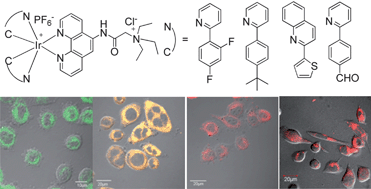Water-soluble phosphorescent iridium(iii) complexes as multicolor probes for imaging of homocysteine and cysteine in living cells†
Abstract
With the emergence of phosphorescent heavy-metal complexes as a class of attractive

* Corresponding authors
a
Key Laboratory for Organic Electronics & Information Displays (KLOEID) and Institute of Advanced Materials (IAM), Nanjing University of Posts and Telecommunications, Nanjing, P. R. China
E-mail:
iamqzhao@njupt.edu.cn, wei-huang@njupt.edu.cn
Fax: +86 25 8586 6008
Tel: +86 25 8586 6008
b
Department of Chemistry, Fudan University, Shanghai, P. R. China
E-mail:
fyli@fudan.edu.cn
Fax: +86 21 55664621
Tel: +86 21 55664185
With the emergence of phosphorescent heavy-metal complexes as a class of attractive

 Please wait while we load your content...
Something went wrong. Try again?
Please wait while we load your content...
Something went wrong. Try again?
Y. Ma, S. Liu, H. Yang, Y. Wu, C. Yang, X. Liu, Q. Zhao, H. Wu, J. Liang, F. Li and W. Huang, J. Mater. Chem., 2011, 21, 18974 DOI: 10.1039/C1JM13513A
To request permission to reproduce material from this article, please go to the Copyright Clearance Center request page.
If you are an author contributing to an RSC publication, you do not need to request permission provided correct acknowledgement is given.
If you are the author of this article, you do not need to request permission to reproduce figures and diagrams provided correct acknowledgement is given. If you want to reproduce the whole article in a third-party publication (excluding your thesis/dissertation for which permission is not required) please go to the Copyright Clearance Center request page.
Read more about how to correctly acknowledge RSC content.
 Fetching data from CrossRef.
Fetching data from CrossRef.
This may take some time to load.
Loading related content
